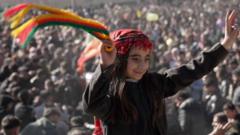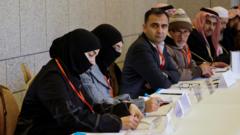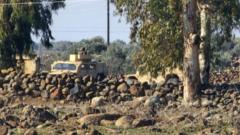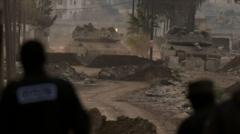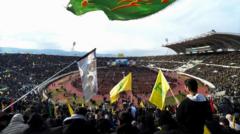Years of Iranian military presence in Syria come to a sudden halt, leaving behind a legacy of ruins and unanswered questions about the future of Iran's influence in the region.**
The Ruins of Iran’s Ambitions in Syria: A Shift in Power Dynamics**
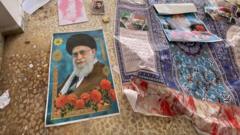
The Ruins of Iran’s Ambitions in Syria: A Shift in Power Dynamics**
Abandoned military sites reveal Iran's hasty retreat, signaling dramatic change in regional alliances.**
Feeling the repercussions of a significant shift in regional power dynamics, Iran’s once-thriving military installations in Syria now lay in disarray. Abandoned bases, echoing with the remnants of a rushed retreat, tell a haunting story of the Islamic Revolutionary Guard Corps (IRGC) and their foreign militia allies, who left behind the stories of a decade-long commitment that collapsed in mere weeks.
Located near Khan Shaykhun in Idlib province, these bases boast an array of decaying supplies — stale food, discarded uniforms, and unguarded weapons — highlighting the panic that enveloped Iranian forces as they fled. The IRGC served as a crucial ally to Syrian President Bashar al-Assad, providing military support, foreign fighters, and a framework for navigating the complex landscape of Syrian warfare. Their presence was designed as a bulwark against perceived threats from Israel, integrating deep-rooted networks within the territory.
Amongst scattered military assets, one base tentatively named after an assassinated commander, Maj. Gen. Mohammad Reza Zahedi, stands as a monument to their shattered ambitions. Eyewitness accounts from local armed groups reveal a swift reconfiguration of control, with Uyghur fighters from Hayaat Tahrir al-Sham (HTS) taking possession of the vacated Iranian-occupied areas mere moments after their exit.
Documents detailing the identities and personal information of fighters were left behind, illustrating the rapid decay of Iranian military organization. This exodus was exacerbated by failures in leadership trust between Iran and the Assad regime, prompting accusations of betrayal amidst a wave of Israeli airstrikes that destabilized Iranian footholds across Syria.
Local residents, witnessing this turbulence, echoed sentiments of relief at the departure of Iranian forces, viewing their presence as an oppressive occupation. As the new Syrian authorities rise to power, there is a clear demarcation: Iranian nationals are now barred from entering Syria, while the perceived threat from Russia remains muted, reflecting a strategic pivot towards Moscow.
The aftermath creates a perplexing dilemma for Iran. While their supreme leader urges resistance against those destabilizing Syria, the response from the Iranian foreign ministry reveals a pragmatic approach, indicating a willingness to accept any government recognized by the Syrian populace. Meanwhile, Syria's emerging leadership has not firmly shut the door on a measured relationship with Tehran, though the current landscape contradicts this possibility.
As the remnants of Iranian military efforts rot away in silenced bases and crumbling infrastructure, the underlying question persists: What will remain of Iran’s influence in Syria and the broader Middle Eastern arena? Signs point to a significant shift, leaving turmoil in the wake of once-ambitious military goals now lying in the dust of unchecked power dynamics.
Located near Khan Shaykhun in Idlib province, these bases boast an array of decaying supplies — stale food, discarded uniforms, and unguarded weapons — highlighting the panic that enveloped Iranian forces as they fled. The IRGC served as a crucial ally to Syrian President Bashar al-Assad, providing military support, foreign fighters, and a framework for navigating the complex landscape of Syrian warfare. Their presence was designed as a bulwark against perceived threats from Israel, integrating deep-rooted networks within the territory.
Amongst scattered military assets, one base tentatively named after an assassinated commander, Maj. Gen. Mohammad Reza Zahedi, stands as a monument to their shattered ambitions. Eyewitness accounts from local armed groups reveal a swift reconfiguration of control, with Uyghur fighters from Hayaat Tahrir al-Sham (HTS) taking possession of the vacated Iranian-occupied areas mere moments after their exit.
Documents detailing the identities and personal information of fighters were left behind, illustrating the rapid decay of Iranian military organization. This exodus was exacerbated by failures in leadership trust between Iran and the Assad regime, prompting accusations of betrayal amidst a wave of Israeli airstrikes that destabilized Iranian footholds across Syria.
Local residents, witnessing this turbulence, echoed sentiments of relief at the departure of Iranian forces, viewing their presence as an oppressive occupation. As the new Syrian authorities rise to power, there is a clear demarcation: Iranian nationals are now barred from entering Syria, while the perceived threat from Russia remains muted, reflecting a strategic pivot towards Moscow.
The aftermath creates a perplexing dilemma for Iran. While their supreme leader urges resistance against those destabilizing Syria, the response from the Iranian foreign ministry reveals a pragmatic approach, indicating a willingness to accept any government recognized by the Syrian populace. Meanwhile, Syria's emerging leadership has not firmly shut the door on a measured relationship with Tehran, though the current landscape contradicts this possibility.
As the remnants of Iranian military efforts rot away in silenced bases and crumbling infrastructure, the underlying question persists: What will remain of Iran’s influence in Syria and the broader Middle Eastern arena? Signs point to a significant shift, leaving turmoil in the wake of once-ambitious military goals now lying in the dust of unchecked power dynamics.









